Solar eclipse of August 11, 1961
An annular solar eclipse occurred on August 11, 1961. A solar eclipse occurs when the Moon passes between Earth and the Sun, thereby totally or partly obscuring the image of the Sun for a viewer on Earth. An annular solar eclipse occurs when the Moon's apparent diameter is smaller than the Sun's, blocking most of the Sun's light and causing the Sun to look like an annulus (ring). An annular eclipse appears as a partial eclipse over a region of the Earth thousands of kilometres wide. A small annular eclipse covered only 94% of the Sun in a very broad path, 499 km wide at maximum, and lasted 6 minutes and 35 seconds.
| Solar eclipse of August 11, 1961 | |
|---|---|
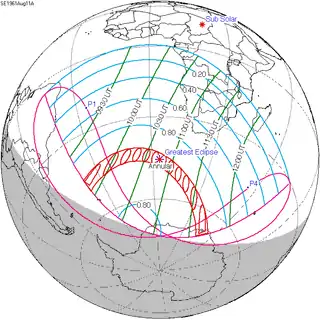 Map | |
| Type of eclipse | |
| Nature | Annular |
| Gamma | -0.8859 |
| Magnitude | 0.9375 |
| Maximum eclipse | |
| Duration | 395 sec (6 m 35 s) |
| Coordinates | 45.8°S 4°E |
| Max. width of band | 499 km (310 mi) |
| Times (UTC) | |
| Greatest eclipse | 10:46:47 |
| References | |
| Saros | 125 (51 of 73) |
| Catalog # (SE5000) | 9423 |
Related eclipses
Solar eclipses of 1961–1964
This eclipse is a member of a semester series. An eclipse in a semester series of solar eclipses repeats approximately every 177 days and 4 hours (a semester) at alternating nodes of the Moon's orbit.[1]
| Solar eclipse series sets from 1961–1964 | ||||||
|---|---|---|---|---|---|---|
| Descending node | Ascending node | |||||
| Saros | Map | Saros | Map | |||
| 120 | 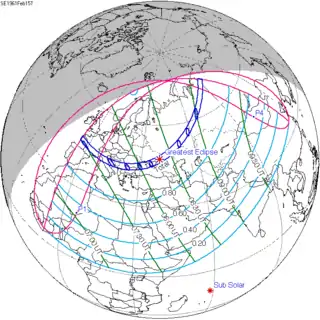 1961 February 15 Total |
125 |  1961 August 11 Annular | |||
| 130 | 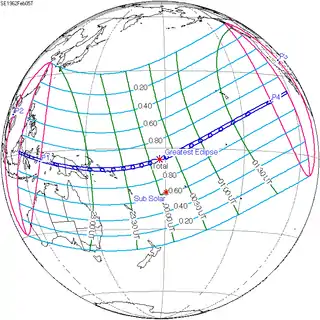 1962 February 5 Total |
135 | 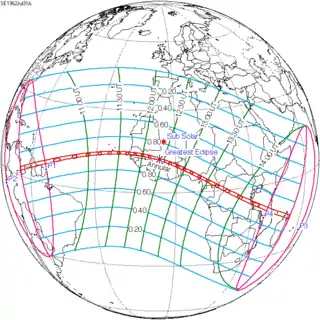 1962 July 31 Annular | |||
| 140 | 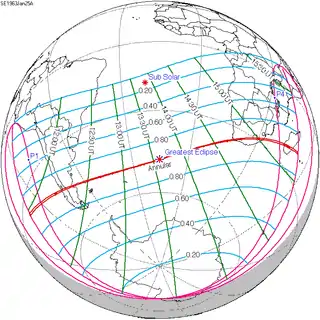 1963 January 25 Annular |
145 | 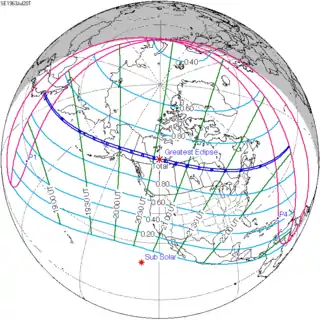 1963 July 20 Total | |||
| 150 | 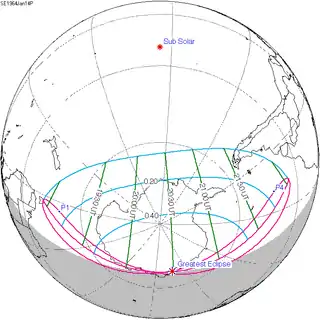 1964 January 14 Partial |
155 | 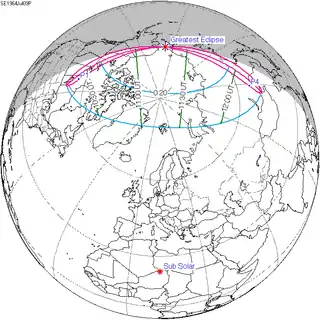 1964 July 9 Partial | |||
| Partial solar eclipses of June 10, 1964 and December 4, 1964 belong in the next lunar year set. | ||||||
Saros 125
Solar saros 125, repeating every about 18 years and 11 days, contains 73 events. The series started with a partial solar eclipse on February 4, 1060. It has total eclipses from June 13, 1276, to July 16, 1330. It has hybrid eclipses on July 26, 1348, and August 7, 1366, and annular eclipses from August 17, 1384, to August 22, 1979. The series ends at member 73 as a partial eclipse on April 9, 2358. The longest total eclipse occurred on June 25, 1294, at 1 minute and 11 seconds; the longest annular eclipse occurred on July 10, 1907, at 7 minutes and 23 seconds.[2]
| Series members 47–58 occur between 1881 and 2100: | ||
|---|---|---|
| 47 | 48 | 49 |
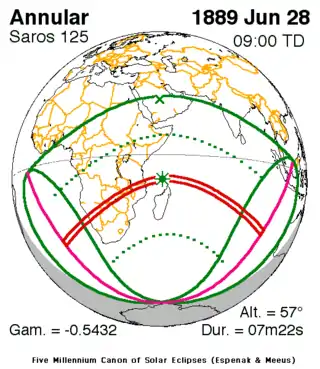 June 28, 1889 |
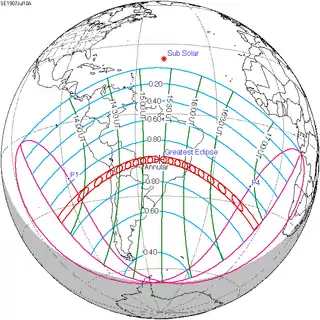 July 10, 1907 |
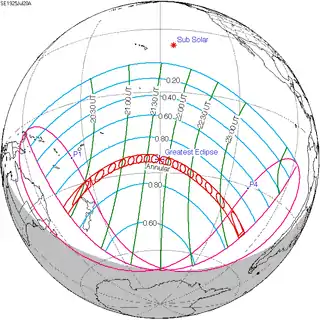 July 20, 1925 |
| 50 | 51 | 52 |
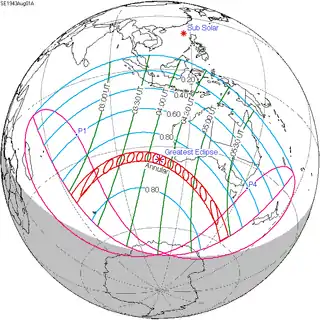 August 1, 1943 |
 August 11, 1961 |
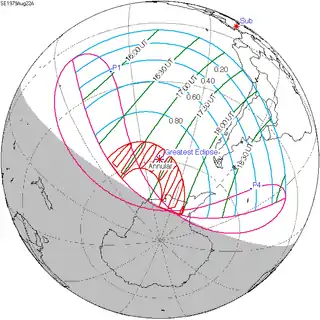 August 22, 1979 |
| 53 | 54 | 55 |
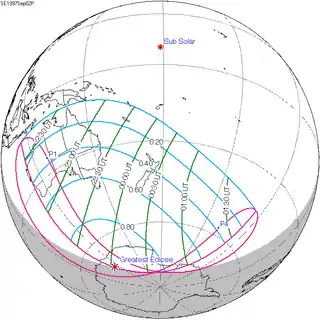 September 2, 1997 |
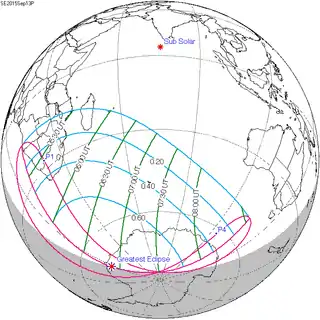 September 13, 2015 |
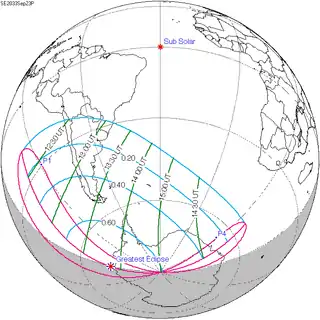 September 23, 2033 |
| 56 | 57 | 58 |
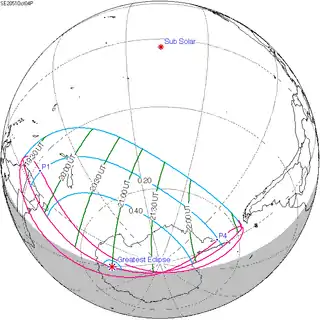 October 4, 2051 |
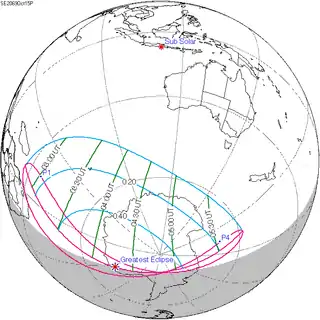 October 15, 2069 |
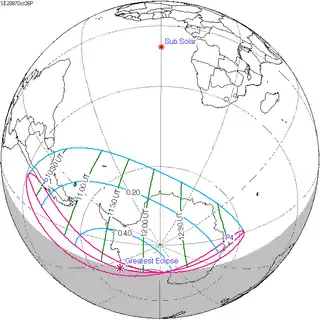 October 26, 2087 |
Inex series
This eclipse is a part of the long period inex cycle, repeating at alternating nodes, every 358 synodic months (≈ 10,571.95 days, or 29 years minus 20 days). Their appearance and longitude are irregular due to a lack of synchronization with the anomalistic month (period of perigee). However, groupings of 3 inex cycles (≈ 87 years minus 2 months) comes close (≈ 1,151.02 anomalistic months), so eclipses are similar in these groupings.
In the 19th century:
- Solar Saros 120: Total Solar Eclipse of 1816 Nov 19
- Solar Saros 121: Hybrid Solar Eclipse of 1845 Oct 30
- Solar Saros 122: Annular Solar Eclipse of 1874 Oct 10
| Inex series members between 1901 and 2100: | ||
|---|---|---|
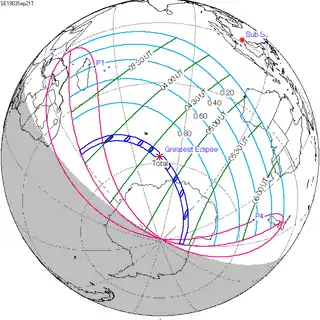 September 21, 1903 (Saros 123) |
 August 31, 1932 (Saros 124) |
 August 11, 1961 (Saros 125) |
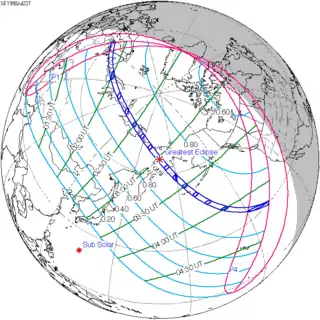 July 22, 1990 (Saros 126) |
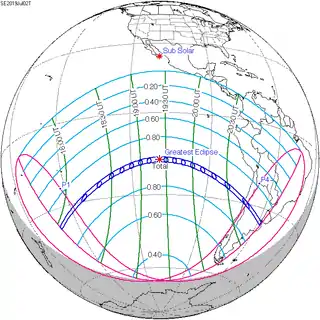 July 2, 2019 (Saros 127) |
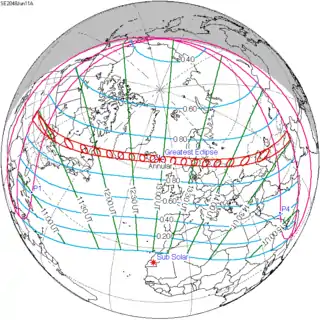 June 11, 2048 (Saros 128) |
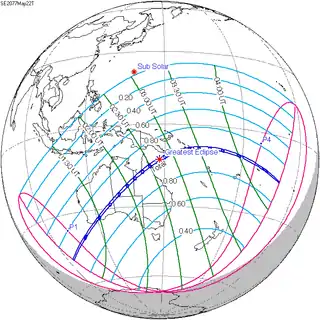 May 22, 2077 (Saros 129) |
||
In the 22nd century:
- Solar Saros 130: Total Solar Eclipse of 2106 May 03
- Solar Saros 131: Annular Solar Eclipse of 2135 Apr 13
- Solar Saros 132: Hybrid Solar Eclipse of 2164 Mar 23
- Solar Saros 133: Total Solar Eclipse of 2193 Mar 03
Metonic series
The metonic series repeats eclipses every 19 years (6939.69 days), lasting about 5 cycles. Eclipses occur in nearly the same calendar date. In addition, the octon subseries repeats 1/5 of that or every 3.8 years (1387.94 days). All eclipses in this table occur at the Moon's ascending node.
| 22 eclipse events between January 5, 1935 and August 11, 2018 | ||||
|---|---|---|---|---|
| January 4-5 | October 23-24 | August 10-12 | May 30-31 | March 18-19 |
| 111 | 113 | 115 | 117 | 119 |
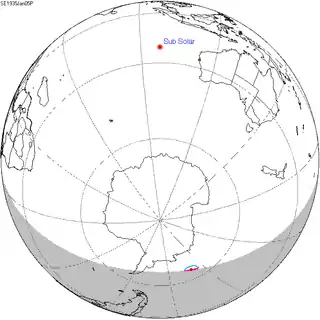 January 5, 1935 |
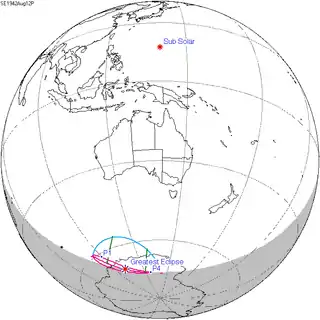 August 12, 1942 |
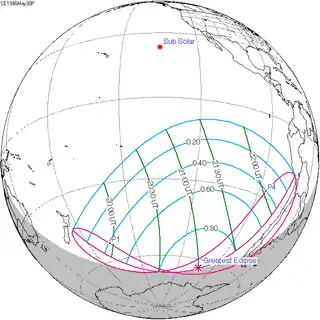 May 30, 1946 |
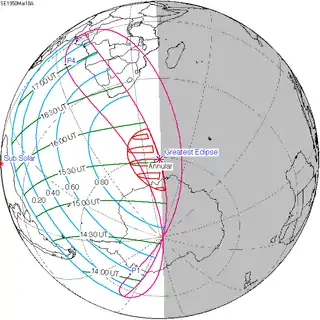 March 18, 1950 | |
| 121 | 123 | 125 | 127 | 129 |
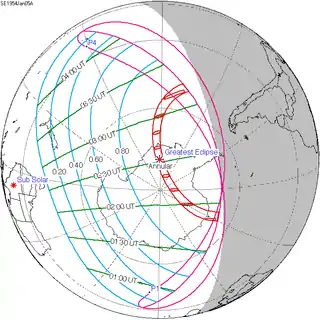 January 5, 1954 |
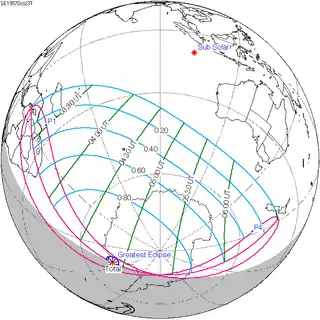 October 23, 1957 |
 August 11, 1961 |
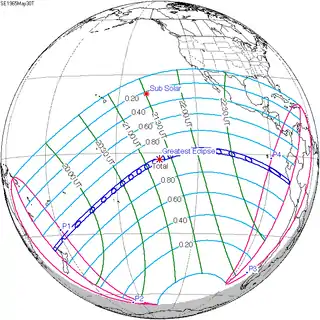 May 30, 1965 |
 March 18, 1969 |
| 131 | 133 | 135 | 137 | 139 |
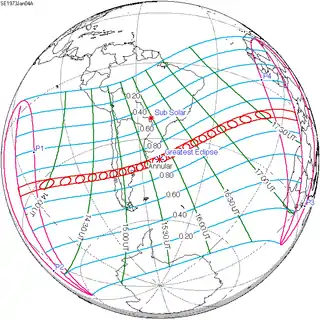 January 4, 1973 |
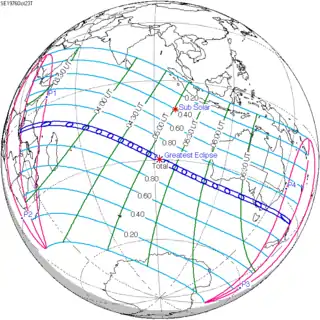 October 23, 1976 |
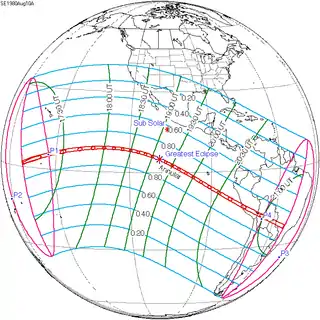 August 10, 1980 |
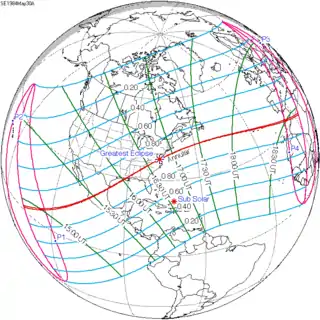 May 30, 1984 |
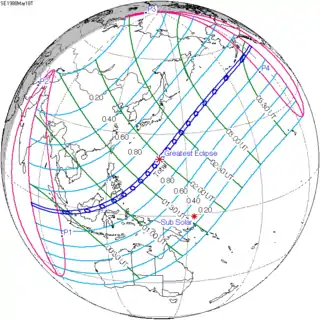 March 18, 1988 |
| 141 | 143 | 145 | 147 | 149 |
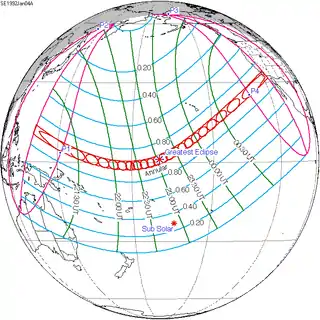 January 4, 1992 |
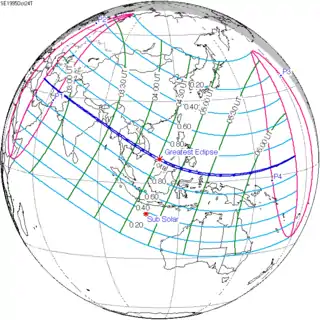 October 24, 1995 |
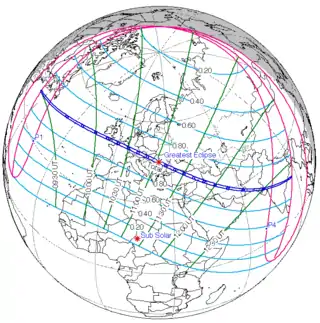 August 11, 1999 |
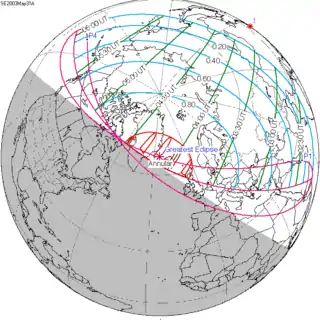 May 31, 2003 |
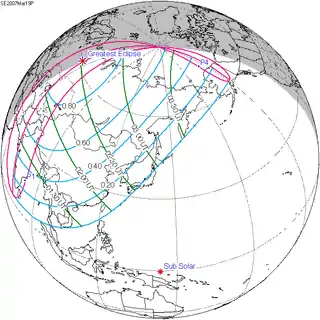 March 19, 2007 |
| 151 | 153 | 155 | 157 | 159 |
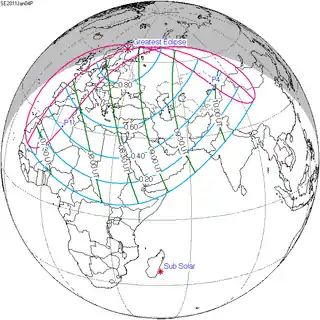 January 4, 2011 |
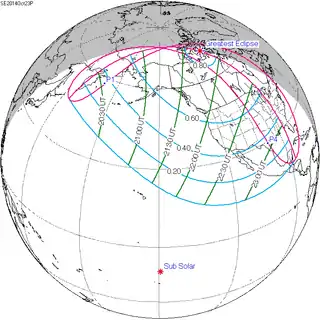 October 23, 2014 |
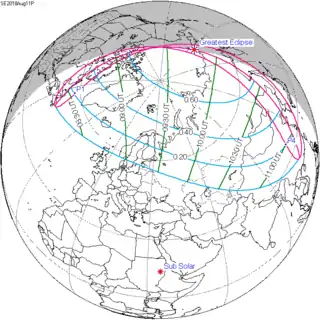 August 11, 2018 |
||
Notes
- van Gent, R.H. "Solar- and Lunar-Eclipse Predictions from Antiquity to the Present". A Catalogue of Eclipse Cycles. Utrecht University. Retrieved 6 October 2018.
- Saros Series Catalog of Solar Eclipses NASA Eclipse Web Site.
References
- Earth visibility chart and eclipse statistics Eclipse Predictions by Fred Espenak, NASA/GSFC
.jpg.webp)

